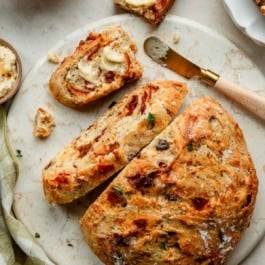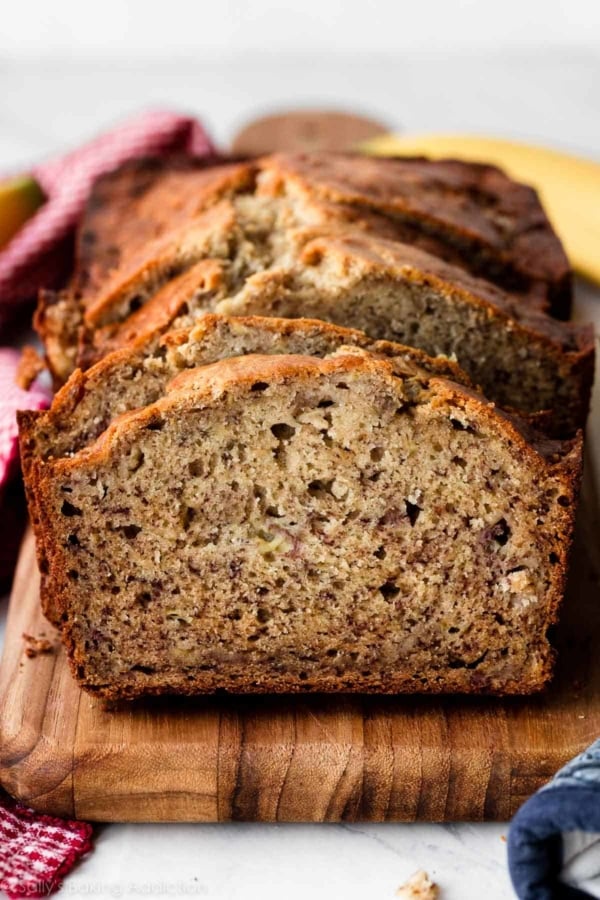This no-knead pizza bread delivers big flavor with barely any effort. The dough rests and rises overnight, so most of the process is completely hands-off—no kneading or tricky shaping required. The result is a bakery-style loaf with a crispy golden crust and a soft, chewy interior, packed with pepperoni, sun-dried tomatoes, olives, and mozzarella. Add a sprinkle of crushed red pepper for pizzeria-style heat, then serve it warm with pizza sauce or tomato soup for dipping, or slathered in hot honey butter for an extra kick.

Today’s recipe, like my homemade artisan bread, seeded oat bread, asiago-crusted bread, cranberry nut bread, jalapeño cheddar bread, and olive bread, has all the bells and whistles of a fresh-from-the-bakery loaf, yet it takes very little effort. If you are new to working with yeast, or are simply in the mood to bake a low-effort bread, this recipe is for you.
One reader, Emma, commented: “Really easy and delicious! This is a great project for someone who is newer at working with yeast. Definitely the most hands-off bread recipe I’ve ever tried but still delicious with big flavor! ★★★★★“
One reader, Jill, commented: “This recipe is a total winner! It’s super easy and quick, and the results are awesome. I made two loaves and it took almost no time at all. Both turned out very well. It’s honestly almost foolproof—try it, you will be so happy you did! ★★★★★“
One reader, Christina, commented: “Simple and delicious! I love a no-knead bread, and this was one of the best ones I’ve had. Mine sat in the refrigerator for the full three days, but I think that made it even better. The hot honey butter complimented this perfectly. ★★★★★“
A Flavorful Bread Recipe for Beginners
If you’re nervous to try homemade bread, this recipe is a great introduction. Even though the recipe is easy, the bread does NOT skimp on flavor. It’s just a simple way of baking homemade bread inspired by the no-knead technique originating from bread expert Jim Lahey. Here’s why it’s so simple:
- Absolutely no kneading (just like homemade English muffins)
- Zero complicated shaping
- No mixer required
- 90% of the time is totally hands off
- Can bake in a Dutch oven or on a baking sheet, pizza stone, or cast iron skillet (all instructions are below!)
Yeast Bread Success Tips
If you’re a bread beginner, reference this Baking with Yeast Guide for helpful, easy-to-understand answers to many yeast FAQs.

Key Ingredients You Need & Why
- Bread Flour: I strongly recommend using bread flour instead of all-purpose flour. Bread flour produces a stronger, chewier bread and that makes a big difference in an artisan-style loaf like this pizza bread or in a recipe like homemade ciabatta bread.
- Instant Yeast: While you can use active dry yeast if that’s all you have, any quick-rise or instant yeast will produce flavorful results in less time. I use more yeast in this recipe compared to my cranberry nut no-knead bread and no-knead jalapeño cheddar bread. Why? Those doughs rest and rise at room temperature. However, for more flavor and just as much rise, I use more yeast and let this dough rest in the refrigerator. (Cool air slows the fermentation process and helps develop better flavor.) Additionally, the mix-ins in today’s bread are heavy, so we need a little extra oomph!
- Salt: I recommend using coarse salt because I find the bread’s flavor lacking with regular table salt.
- Sugar: Just a little sugar helps balance all the savory, salty flavors, and also increases yeast activity. You could use honey instead if desired.
- Seasonings: Dried oregano, basil, and garlic powder add flavor to the dough. For a little pizzeria-style heat, add some crushed red pepper flakes. How spicy you like your pizza bread is up to you!
- Mix-ins: This is where you can play around with your favorite pizza toppings. See below for my recommendations.
- Mozzarella Cheese: You can use either shredded mozzarella, or diced fresh mozzarella cheese. In our testing, we found that the bread with the chunks of fresh mozzarella spread a little more. But both ways tasted delicious.
- Water: I normally encourage you to use warm liquid with yeast, like we do in no-knead seeded oat bread, because warm liquid helps the yeast work faster. However, use cool or room-temperature water here. 70°F (21°C) is great, but the exact temperature doesn’t matter as long as it’s not warm. We use the same cool-water method for no-knead honey oat bread.

Choose Your Pizza Toppings to Mix Into the Dough
In our recipe testing, the crowd favorite pizza bread included a mix of pepperoni, sun-dried tomatoes, and olives.
But you can adapt the mix-ins to your taste—just keep them to about a heaping cup altogether. If you don’t like olives, for example, simply replace them with more pepperoni and sun-dried tomatoes. (And if you LOVE olives, try this similar recipe for no-knead olive bread!) You can also try cooked and crumbled sausage, caramelized onions, and/or diced ham.
In addition to those pizza toppings, we’ll also add mozzarella cheese.
In Photos: Making No-Knead Pizza Bread
Mix the dry ingredients together and then mix in the pizza toppings and water. Use a spatula at first and then switch to your hands, if needed, to ensure all of the flour is moistened.

The dough is sticky after it’s thoroughly mixed:

Let it rise. Cover the dough and let it rise at room temperature for 3 hours.
The dough will rise OUT instead of rising UP. After 3 hours, place the dough in the refrigerator for at least 12 hours and up to 3 days. Here is the dough after 24 hours of refrigeration:

After the dough rises and rests in the refrigerator, use generously floured hands to shape the dough into a round boule or ball-like shape. Let it rest for 30 minutes as the oven preheats, and then score the surface with a bread lame or sharp knife. Scoring allows the wet, airy dough to “breathe” and expand as it bakes.

Use a Dutch Oven, Baking Sheet, or Cast Iron Skillet
You’ll bake the pizza bread in a pre-heated (super-hot!) covered Dutch oven, which traps steam inside the pot, helping to create that perfectly crusty, shiny exterior. If you plan to bake a lot of bread in the future, you won’t regret picking up a Dutch oven.
No Dutch oven? No problem. While baking the bread in a Dutch oven is key to this bread’s texture, you can get around it. Here are a few other options:
- Baking Sheet: Unlike a Dutch oven, cast iron skillet, or pizza stone, a baking sheet doesn’t retain heat as well, and since it doesn’t trap steam, the bread won’t develop quite the same crisp, crusty exterior (arguably the best part!). That said, a baking sheet is the most convenient option for many home bakers. To improve the crust, I suggest adding steam to your oven, and I explain how in the recipe Note below. This is a trick I use when baking my 4-ingredient artisan bread.
- Pizza Stone or Cast Iron Skillet: These options are fantastic if you don’t have a Dutch oven. They hold more heat than a baking sheet, but again, there’s no trapped steam inside the oven. To improve the crust, add steam to the oven using the method described in the Note below.
The bread is unbelievable when it’s fresh from the oven—warm, crispy, crusty, and soft and chewy inside!

Because of the sticky dough and cheese, this bread is flatter than most boules. But this just means a higher crust-to-interior ratio! Perfect for dunking.

What Can I Serve With This Pizza Bread?
Honestly, it’s fantastic all on its own. With all of the add-ins, cheese, garlic, and herbs, there’s SO much flavor in every single bite. However, here’s what we enjoyed:
- Warm marinara sauce for dipping
- Tomato soup or minestrone soup
- Flavorful dipping oil: Mix together 3 Tablespoons extra virgin olive oil and 2 minced garlic cloves plus a sprinkle each of red pepper flakes, fresh or dried thyme leaves, dried oregano, salt, and pepper.
- Hot honey butter! A spread of sweet-and-spicy hot honey butter on a warm slice of this pizza bread isn’t strictly necessary… but once you’ve tasted it, you’ll likely agree with us that it actually is necessary. It’s quick and easy to make, just like my classic homemade honey butter. I included the recipe below!

Crusty No-Knead Pizza Bread with Hot Honey Butter
- Prep Time: 30 minutes
- Cook Time: 35 minutes
- Total Time: 14 hours
- Yield: 1 loaf; 10-12 servings
- Category: Bread
- Method: Baking
- Cuisine: American
Description
This no-knead pizza bread delivers big flavor with barely any effort. The dough rests and rises overnight, so most of the process is completely hands-off—no kneading or tricky shaping required. The result is a bakery-style loaf with a crispy golden crust and a soft, chewy interior, packed with bits of pepperoni, sun-dried tomatoes, olives, and mozzarella. Serve slices warm with pizza sauce or tomato soup for dipping, or slathered in hot honey butter for a touch of sweet heat! If you’re new to working with yeast, reference my Baking with Yeast Guide for answers to common yeast FAQs.
Ingredients
- 3 and 1/3 cups (about 440g) bread flour (spooned & leveled), plus more as needed for shaping and pan
- 2 teaspoons instant or active dry yeast
- 2 teaspoons coarse salt*
- 1 teaspoon granulated sugar (or honey, see Note)
- 2 teaspoons dried oregano
- 1 teaspoon dried basil
- 1 and 1/2 teaspoons garlic powder
- 1/4 teaspoon crushed red pepper flakes, optional
- 1 heaping cup (about 135g) chopped pepperoni, sun-dried tomatoes (packed in oil & drained), and/or olives
- 1 cup (113g) shredded mozzarella cheese
- 1 and 1/2 cups (360ml) water, close to room temperature at about 70°F (21°C)
Optional Hot Honey Butter
- 1/2 cup (8 Tbsp; 113g) unsalted butter, softened to room temperature*
- 3 Tablespoons (63g) honey
- 1 Tablespoon confectioners’ sugar
- 1/8–1/4 teaspoon flaky sea salt or coarse salt
- pinch of crushed red pepper flakes, to taste
Instructions
- *No need to grease the bowl, and do not use a mixer in this step because the dough is too sticky for a mixer.* In a large mixing bowl, whisk together the flour, yeast, salt, sugar, oregano, basil, garlic powder, and crushed red pepper (if using). Using a silicone spatula or wooden spoon, mix in the chopped add-ins (pepperoni, sun-dried tomatoes, olives) and mozzarella cheese. Pour in the water and gently mix together. The dough will seem dry and shaggy, but keep working it until all the flour is moistened. If needed, use your hands to work the dough ingredients together until all the flour is moistened. The dough will be sticky. Shape into a ball in the bowl as best you can.
- Cover the bowl tightly with plastic wrap or aluminum foil and set on the counter at room temperature. Allow to rise for 3 hours. The dough will just about double in size, stick to the sides of the bowl, and have a lot of air bubbles. Place the risen dough, still covered, in the refrigerator for at least 12 hours and up to 3 days. The dough will puff up during this time, but may begin to deflate after 2 days. That’s normal.
- Turn the dough out onto a lightly floured work surface and, using generously floured hands, shape into a ball as best you can. It doesn’t have to be perfect. Transfer the dough to a large piece of parchment paper. (Large enough to fit inside your pot and one that is safe for high heat. I use this parchment and it’s never been an issue.) Place the ball of dough + parchment inside a medium-size mixing bowl so the dough doesn’t spread out as it rests. Cover and let it rest for 30 minutes.
- During this rest, preheat the oven to 450°F (232°C). (Yes, very hot!) Place a 6-quart or larger Dutch oven (with the lid) or heavy-duty pot in the oven for 30 minutes so that it’s extremely hot before the dough is placed inside.
- After 30 minutes, using a very sharp knife or bread lame (some even use kitchen shears), score the dough with an X, about 1/2 inch deep. (“Score” = shallow cut.) Remove the Dutch oven from the oven and carefully place the scored dough inside by lifting it up with the parchment paper and placing it all—the parchment paper included—inside the pot. Cover with the lid.
- Bake for 25 minutes with the lid on. Carefully remove the lid and continue baking for around 10–15 minutes more until the bread is golden brown. How to test for doneness: Give the warm bread a light tap. If it sounds hollow, it’s done. For a more accurate test, the bread is done when an instant-read thermometer reads the center of the loaf as 195°F (90°C).
- Remove pot from the oven, carefully remove the bread from the pot, and allow to cool on a cooling rack for at least 20 minutes before slicing. Because of the heavy add-ins and cheese, this bread is flatter than most boules. But this just means a higher crust to interior ratio! Slice and serve with homemade hot honey butter, if desired.
- Make the hot honey butter: In a large bowl using a handheld mixer or stand mixer fitted with a paddle attachment, beat the butter on medium speed until completely smooth and creamy, about 1 minute. Add the remaining ingredients, starting with only 1/8 teaspoon of salt and a small pinch of red pepper flakes. Beat on medium-high speed until completely smooth, about 1 minute. Scrape down the sides of the bowl with a silicone spatula and beat again as needed to combine. Taste. Add more salt and/or crushed red pepper flakes if desired.
- Store leftovers loosely covered at room temperature for up to 3 days or in the refrigerator for up to 1 week. Tightly cover leftover hot honey butter and store at room temperature for up to 2 days or in the refrigerator for up to 2–3 months.
Notes
- Make Ahead & Freezing Instructions: The dough can sit in the refrigerator for up to 3 days, so this is a wonderful recipe to begin ahead of time. You can also bake the bread, allow it to cool, wrap it tightly and freeze for up to 3 months. Thaw in the refrigerator and allow to come to room temperature before serving. You can also freeze the dough. Complete the recipe through step 2. Wrap in plastic wrap and place in a freezer-friendly container or zip-top bag. Freeze for up to 3 months. To bake, allow dough to thaw overnight in the refrigerator, or for 2–3 hours at room temperature. Continue with step 3 and the rest of the recipe instructions. You can freeze hot honey butter for up to 6 months. Thaw in the refrigerator before using. If desired, after it has thawed, you can bring it to room temperature and beat with a mixer until it’s extra creamy.
- Special Tools (affiliate links): Glass Mixing Bowls | Wooden Spoon or Silicone Spatula | Dutch Oven | 2-Cup Measuring Cup | Parchment Paper | Bread Lame | Instant-Read Thermometer | Electric Mixer (Handheld or Stand) | Coarse Sea Salt | Flaky Sea Salt
- Flour: For absolute best flavor and chewy texture, I strongly recommend using bread flour. You can use a 1:1 substitution of all-purpose flour in a pinch with no other changes to the recipe. I recommend avoiding whole wheat flour in this dough. The bread will be extremely dense and heavy. Instead, try my whole wheat bread.
- Yeast: You can use instant or active dry yeast, but I highly recommend an instant (aka “rapid rise” or “quick rise” yeast). The bread will rise faster. 2 teaspoons is a little less than 1 standard packet. If using active dry yeast, there are no changes needed to the recipe. The rise time in step 2 may take longer. Reference my Baking with Yeast Guide for answers to common yeast FAQs.
- Salt: Use a coarse salt, such as coarse sea salt, in this bread. I find the flavor slightly lacking when using regular table fine salt. If you only have fine salt, reduce to 1 and 1/2 teaspoons.
- Sugar: A little sugar helps balance all the strong savory and salty flavors in this bread. Instead of granulated sugar, you can use honey. If using honey, instead of mixing it into the dry ingredients like you would the sugar, whisk it into the water you use in the dough.
- Garlic & Herbs: Feel free to use 2–3 teaspoons chopped fresh oregano and/or fresh basil instead of dried. Instead of garlic powder, you can use 2 teaspoons minced fresh garlic or roasted garlic.
- Instructions If You Don’t Have a Dutch Oven: If you don’t have a Dutch oven, you can still bake this bread on a baking sheet, pizza stone, or cast iron skillet. Baking Sheet: Place the shaped dough on a parchment-lined or generously floured (or cornmeal-dusted) baking sheet in step 3, cover, and let rest for 30 minutes. While the oven preheats (step 4), bring a kettle of water to a boil. Once the dough is scored (step 5), place the baking sheet on the center rack and a shallow metal pan (not glass) on the bottom rack. Carefully pour 3–4 cups of boiling water into the pan to create steam, then quickly shut the oven door. The steam helps give the bread a crisper crust like you’d get in a Dutch oven. Bake for around 35–38 minutes and check for doneness with an instant-read thermometer as described in step 6. Pizza Stone or Cast Iron Skillet (10–12-inch): You can preheat the stone or cast iron skillet in the oven in step 4 for a slightly crisper crust (or skip preheating if you prefer) and you can also add steam to the oven, as described in the baking sheet method. After scoring the dough in step 5, transfer it (on parchment, since the dough is very sticky) onto the hot stone or skillet. Bake as directed, but note that the bread may finish a little faster, so keep an eye on it and check for doneness with an instant-read thermometer as described in step 6.



















Reader Comments and Reviews
Not sure what I did wrong, but after an additional 12 minutes my bread had still not reached 195°! I had to take it out of the oven as the top was getting too dark. And when I removed from the Dutch oven after cooling, I saw that the bottom was burned. Inside was still a little doughy as well. Still tastes great though!
This is so yummy and easy to make! For the inclusions I use salami instead of pepperoni and sharp provolone instead of mozzarella (both cubed) and 1/3 cup each of sundried tomatoes, roasted red peppers, and olives. And I substitute Italian seasoning for oregano.
Just made this bread base and it is really scrumptious! This was my first time making bread and it could not have been easier. I made it without the pizza ingredients just to see how it would come out. Cannot wait to make with pizza and other ingredients. Thank you for the recipe and tips!
if the pizza bread hasn’t doubled in size after 3 hours, should I leave it out longer until it doubles in size?
Hi Diane! We would leave it until it doubles in size – a warmer spot will help it rise faster!
Hi sally, did I miss a step after chilling for 12 hrs? There is nothing about bringing to room temperature, just the 30 minute rest after shaping while oven/dutch oven preheat. The loaf didn’t rise much, took much longer to bake, and is fairly dense.
Hi Katie! No, you don’t need to bring the dough room temperature after chilling. Make sure to handle the dough very carefully to prevent popping any air bubbles! This bread won’t rise a ton, with all the heavy and delicious add-ins. Did your bread look like the photos?
Hi Trina, I certainly may have been too aggressive in shaping it. It had deflated a bit in the refrigerator, but I guess I didn’t realize I should have handled it more gently and left it a bit more “rustic”.
I will definitely try again, as the flavor was very nice and we love a good bread with stuff mixed in. Thanks for your reply!